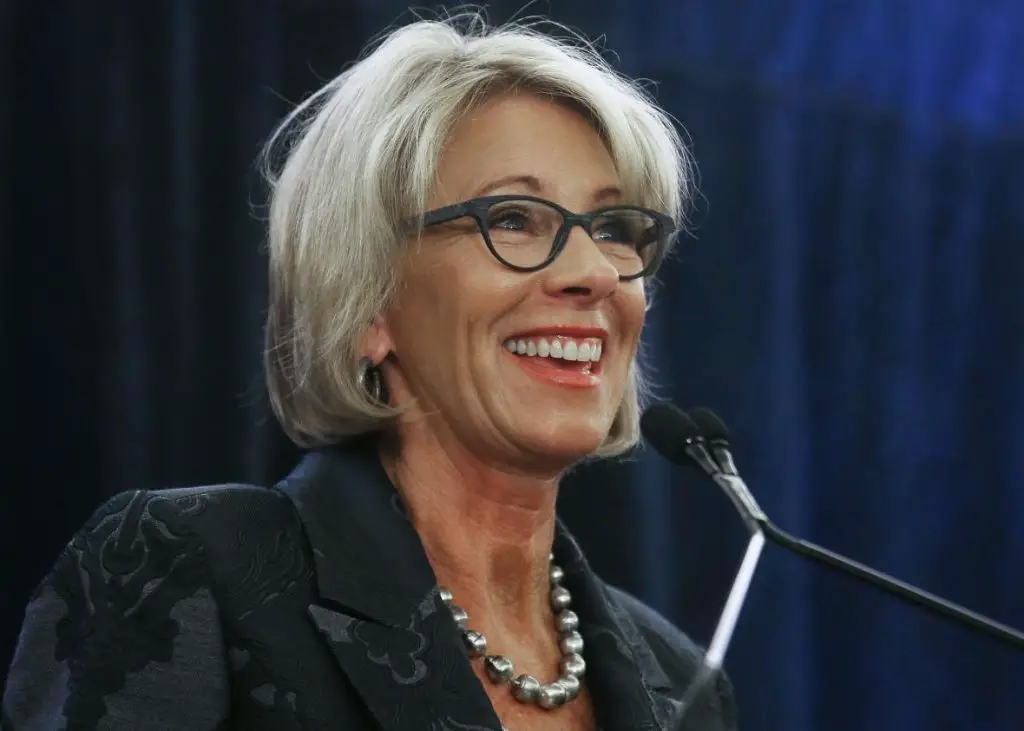Over the last ten years, more than 550,000 students have applied for the Public Service Loan Forgiveness program, making a commitment to put their dreams on hold in order to invest in careers that will allow them to pay off thousands of dollars of university debt.
This October, the first wave of loan-forgiveness recipients, who applied for the program after its inception, in 2007, under the Bush administration, will have the remainder of their debt relieved with no apparent cost to the government.
In May, President Donald Trump and United States Secretary of Education Betsy Devos proposed big cuts to the Department of Education’s new budget, one of which was the possible elimination of the Public Service Loan Forgiveness Program (PSLF) altogether. If the proposal is accepted, its cuts could trim the Department of Education’s budget by more than $10 billion.
When explaining his reasoning for the proposal, the president remarked that the government “shouldn’t be making money off student loans.” The president’s suggestion ignores the fact that the program was made specifically for the purpose of encouraging Americans to go into public service jobs, while also offering a way for students to start payments toward their debt immediately after graduating.
Critics of the program, however, applaud the suggestion, as they have decried the PSLF for the way it makes low-paying service jobs appealing to students, an incentive that they claim encourages students to take out larger amounts of debt. Obama’s administration proposed capping the amount of debt that would be forgiven, but Trump and DeVos want to get rid of the program entirely. If the cuts are accepted, students and recent grads can expect their repayment options to undergo several changes.
What Is the Public Service Loan Forgiveness Program (PSLF)?
Congress created the PSLF program under the College Cost Reduction and Access Act of 2007 as a way to shorten the time it takes for individuals to pay off their debt in exchange for working in public service full-time. Applicants must be financially qualified and employed by an approved employer, under whom they will be required to make a minimum of 120 payments on their Direct Loans, including Direct PLUS loans.
Qualifying employers include all federal, state, local and tribal government agencies/organizations, including most non-profits; U.S. military employees, public transportation workers, public school teachers and university-systems employees are also eligible. Full-time, by definition, is at least 30 hours a week.

After making all 120 payments, individuals are eligible to apply for loan forgiveness. Unfortunately, loans forgiven under the PSLF are not taxable by the IRS. Although there is no income-requirement qualification, the payment plans are based on the individual’s income level and work in conjunction with the qualified employer to determine whether or not the resulting payments will cover the 120 required payments.
All income-driven and 10-year standard repayment-plans qualify under the PSLF program (though the program discourages borrowers from opting in to a ten-year plan and partaking in the PSLF, because a 10-year plan means you have paid off your debt in ten years, so the PSLF would have nothing to forgive).
Under the income-driven repayment plan, borrowers will be required to pay a minimum of 10 percent of their income toward paying off their loans. Paying extra monthly will not make you eligible for forgiveness sooner, and repayment cannot commence before the end of the six-month grace period granted to recent graduates or individuals who are no longer enrolled full-time.
The Benefits of DeVos’ Proposal
With Trump and DeVos’ proposed revisions to the way borrowers can pay off their loans, there will be no PSLF. Regarding the income-driven plan, the revisions reduce the number of years you have to pay, from 20 to 15, but increase the percentage of your income required, from 10 to 12.5 percent. Although interest will increase by 2.5 percent, the repayment period will be shortened, which means less interest accrued over time. Those with advanced degrees, however, will end up paying more over the long haul.
Universities will be pushed to cut tuition and pass savings along to students. With tuition cuts, students will not need to take out as many loans, and more students will have the opportunity to enroll in higher education without the stress of finances.
Universities will also be required to spend all endowments on students. With an increase in the amount of money being offered to students via universities, administrations will be forced to present well-defined requirements for students who are eligible to receive these endowments.
The Demerits of DeVos’ Proposal
The plan put forth by DeVos and Trump reduces the amount of Perkins loan funding and number of work-study programs, which are both important programs for students below the middle class or those putting themselves through college without familial assistance.
Perkins funding offers students low-interest loans of 5 percent, which is made up of government money and a share from the university in attendance. The grace period allotted for Perkins loans are nine months, and individuals are allowed up to 10 years to pay them off.
Work-study programs allow less fortunate students the opportunity to work toward the same education many other students are privileged to acquire. It adds the stress of a job alongside academic course loads, but ultimately it encourages discipline in the students that will transfer into public service jobs in the future.
Additionally, students will have the opportunity to consolidate multiple federal loans into a single loan, which will result in single monthly payments rather than multiple small payments, a move that is a financial mixed bag. Unfortunately, consolidating loans will increase the period of time required to repay the loans, which could result in graduates paying more interest and losing some interest-rate discounts that some borrowers have to offer.
Why Does It Matter to You?
When I first heard about the new budget proposal I was stressed, because I am a senior in college who plans to graduate a month before the budget would go into effect. As a result, I will be among the thousands of students who will experience the first wave of this huge shift in loan repayment that could affect our post-grad finances. Freshmen year, I applied for quite a few loans because I, like many students in this country, am not receiving familial assistance in paying for my university.
When I signed up for the loans, I did so with the knowledge of the current Student Loan Forgiveness Plan; I planned my post graduation life around the availability of the SLFP. Now that the Trump administration stands ready to pull it out from beneath my feet, I find myself scrambling to come up with another option, or will be forced to acquiesce to his new plan and hope it works out. (We all know Trump’s track record with financing institutions of higher learning, so my expectations are low.)
At the end of the day, my question will always be: Why am I being punished for 1) pursuing an advanced degree and 2) borrowing money to finance this financially straining, yet required degree just to live in debt for the rest of my life? Prospering in this country mandates higher education, but fails to put programs in place that make that necessity attainable for the 47 percent of families that need assistance paying for college. When applying for loans this coming fall semester, be mindful of the plan that you may be signing if Trump and DeVos’ education budget cuts become official.

















